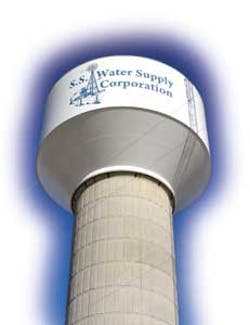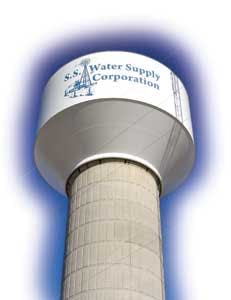Master Planning: Hydraulic Modeling Provides Power to Plan More Accurate Future
By Eric Schulze
Hydraulic modeling is essential for master planning and designing infrastructure improvements that will satisfy current and projected water system needs. Energy and continuity equations may be easily solved when dealing with only a few pipes, but calculating the friction losses, flows and pressures that occur within a complex system's network of pipes requires a more robust solution. Today, this solution is the hydraulic model.
Significant advances in dynamic, hydraulic modeling methods are now providing engineers with the platform to produce meaningful performance data. This data is used to accurately predict future decisions affecting complex water systems and create effective master plans for system expansion, maintenance and repair. The hydraulic model is the key tool for planning, budgeting, constructing, and evaluating water distribution systems and upgrades using advanced simulations and data sources.
Basic Hydraulic Modeling
A hydraulic modeling steady-state analysis is used to demonstrate the water flow rates, friction losses and pressures that occur within a water system at a chosen demand. Further, it allows systems to be analyzed at a static condition to ensure pressures within the water system do not exceed the pressure ratings of its water lines and determines whether a system can maintain pressures required by the state during peak demands.
During the design process, engineers utilize hydraulic model steady-state analysis to determine the proper operational pressure range of water plants and the most efficient size of water lines. The model also facilitates the review process of new meters and subdivisions. Its power to project helps engineers and planners anticipate what effects development will have on a water system and whether improvements must be implemented. Steady-state analysis is a quick and simple way of providing design information and finding deficiencies within a water system; however, it is no replacement for extended- period analysis when it is necessary to fully understand how a water system operates over a period of time.
Extended Period Simulations
While steady-state models provide engineers with the information needed to decipher whether a system has the capability to meet a certain fixed demand, extended-period simulations provide a deeper look into a system's ability to serve customers over a period of days, hours or even minutes. This in-depth analysis provides managers with a more accurate look into how their systems are truly operating and delivers opportunities for significant cost savings. Such knowledge is useful for both day-to-day system operations and planning for future growth.
Conducting an extended-period simulation of an existing water system provides considerably more information than a steady-state analysis. For example, a steady-state model run shows pressure throughout a system at one moment in time. With an extended-period simulation, engineers are able to model how pressures and flows vary as demand changes over time. They can then apply this information to see how pumps and tanks respond to those changes in demand.
With an empirical understanding of how a system is supposed to operate, engineers can more readily pinpoint the cause of an occurring problem. For instance, McCoy Water Supply Corporation, a large rural water system south of San Antonio, Texas, was struggling to maintain the correct water level in one of its standpipes. The team at Southwest Engineers used an extended-period simulation to analyze the demand of individual customers over time and identify multiple reasons why the water supply could not refill the standpoint. The resulting diagnosis of four key customers' consistent high water demand on weekends, coupled with a pipeline break and pump failure that prevented the tank from refilling, equipped the team to offer immediate solutions and prevent the problem from arising again.
The same principles apply when considering system upgrades. When designing a new plant, extended-period modeling can provide an engineer with a good idea of how that plant will respond to changes in demand both upstream and downstream. In this way, the plant can be designed to operate as efficiently as possible.
Extended-period simulations provide the most thorough results available, which means their input data requirements are, for good reason, much denser than those of steady-state runs. In addition to basic steady-state requirements, the following data is necessary for the extended- period simulations made possible by hydraulic modeling:
- Specific water usage and demand patterns of various usage categories in a system
- In-depth tank information, including tank volume, shape and fill control-settings
- Operational rules for pumps and valves
- Pump configurations and curves
GIS and Advanced Data Collection
GIS data should be used to accurately locate water lines, water meters and valves. The data readings can then be imported into a hydraulic model to greatly improve its overall accuracy. Models in coordinate systems also allow engineers to insert informative background maps such as aerials, parcel maps, floodplain maps, and contour maps.
Another source for advanced data collection is automatic meter readings (AMR), which are continuing to replace standard water meters in water systems. AMR meters save the time and cost of monthly meter readings and provide more useful data for water systems. AMR meters give readings that can be compiled to determine typical daily demand, as well as peak demands. The daily demands can then be imported into the hydraulic model to increase the accuracy of the extended-period analysis.
Capital Improvement Planning
Hydraulic models are an essential tool for creating the capital improvement plans that are key to successful master planning. Hydraulic simulations provide the answers to important capital improvement questions: Can the existing infrastructure handle anticipated growth and development? If not, what infrastructure must be built to accommodate future demand?
Capital improvement plans foster superior planning and construction by systematically and holistically evaluating all potential water projects before a growth crisis occurs. This includes running scenarios to ensure existing infrastructure is being utilized to its fullest potential, i.e., maximizing flow in water lines, eliminating poor tank turnover and creating master plans that determine future infrastructure needs.
A master plan can be used, for example, when deciding the best course of action for water-line replacement. Instead of installing a small, ill-proportioned line and then in a few years having to supplement it with another line, a master plan - together with hydraulic modeling and data inputs - provides the information necessary to identify, design and install the correct lines now for the inevitable growth of the future. Right of Way space is also quickly becoming more and more limited, making future expansions much more difficult than those currently taking place. Although this process may incur a higher immediate cost, it pays off in the long run with a healthier, lower- maintenance installment for years to come.
Southwest Engineers applied these and other forward-thinking strategies to outline a complete list of necessary water infrastructure improvements for the S.S. Water Supply Corporation, a fast-growing rural water system southeast of San Antonio. The company also provided S.S. Water Supply with specific cost estimates for all future improvement scenarios, allowing the fast-growing system to modify its impact fees and better fund future improvements.
This in-depth approach made use of historical growth patterns, densities and water usage to plan for a system that would maintain proper capacity and pressure at build-out. The system now has a capital improvement plan ready to handle rapid growth and development at any time and in any form.
Conclusion
Dynamic hydraulic modeling methods are highly valuable in the day-to-day operations and master planning of complex water distribution systems. With GIS information, automatic meter readings and extended-period simulations, water systems can be modeled precisely to reflect actual operating conditions. The hydraulic model can also be used to analyze other aspects of a water system such as water quality, water age, hydrant flows, surge analysis, and system operating cost. It's becoming a money-and-time-saving standard for engineers and clients in need of cost-effective, future-focused infrastructure design.
About the Author: Eric Schulze, Project Engineer, Southwest Engineers, is a licensed engineer and has extensive experience designing water distribution, water treatment and water storage projects for municipalities and public entities. His priority as project engineer is solving problems to save clients time and money.

